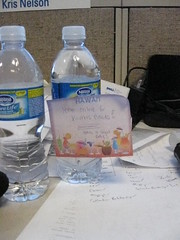So what can I say, sometimes I do things a little backwards. Normally, its the people who are used to their point and shoot cameras that need a little extra help with, and take a little longer to learn about the more complex settings of a Digital SLR camera. Well, after using my Canon EOS 20D for two years and picking up a Canon SD890 as an anywhere/anytime take-along camera, its the point and shoot camera that I’m still learning about after two months later.
When I tried to shoot the flurries outside here in Chicago yesterday during my lunch break, all I had with me was my SD890 (again anywhere, anytime). Trying to catch the giant snowflakes whizzing around my car window with the normal modes from the SD890 just wasn’t working. They snow was flying too fast and the shutter was taking too long. Everything was coming out blurry.
 The Solution
The Solution
Flipping through the Scene (SCN) options, I found the ISO 3200 setting and gave it a shot. To my amazement, the photo appeared on the screen almost instantly, way faster than using the normal shutter mode. After a few attempts, I was able to snap the photo on the right here, which was just what I was looking for. While you can only see the biggest snowflakes in this small thumbnail, click on the image to view the large size on Flickr to see the tiny flakes in more detail.
Not only was I happy to get the photo I wanted, I was also excited because I had a way to capture a wider range of photos for moments that wouldn’t be possible with slower shutter speeds. Remember, I’ve been shooting mainly with a DSLR, so this was a new problem to me.
Drawbacks
Of course, something this helpful will also come with it’s share of drawbacks. The first is in relation to the photo’s size, which isn’t too bad. Shooting with the SD890 in ISO 3200 mode puts your image size to a maximum setting of 3M, which is roughly equivalent to 3 MegePixels. It also restricts the resolution of your image to 1600×1200. Still, that’s pretty decent to use in cases where you would otherwise miss out on a shot altogether.
 Now, just like with DSLR and even film cameras, the higher the ISO setting for film or an image processor, the more “noise” you will see in your photos. Depending on the situation, this can mean quite noticeable degradation in the fine details and quality of a photo. For example, the photo on the left here was taken in ISO 3200. Now, this is just a set scene and there’s no real reason why it has to be taken in the SD890’s ISO 3200, but it proves the point about the image noise that can result.
Now, just like with DSLR and even film cameras, the higher the ISO setting for film or an image processor, the more “noise” you will see in your photos. Depending on the situation, this can mean quite noticeable degradation in the fine details and quality of a photo. For example, the photo on the left here was taken in ISO 3200. Now, this is just a set scene and there’s no real reason why it has to be taken in the SD890’s ISO 3200, but it proves the point about the image noise that can result.
Once again, click on the photo to view the larger size on Flickr. If it was taken with the normal shooting mode of the camera (which I should have done for further comparison here), the details of the handwritten note on the Post-It would be a lot more legible, and you could probably even read my own chicken scratch on the pages underneath the bottle of water. With a proper settings and exposure time, this image, and all of the camera’s 10MP glory, would have been so much better.
What took so long?
Why did it take so long for me to figure this out? I can’t really tell you, other than the fact I don’t really read instruction guides as much as I should. I have known for years now that, for low-light and night photography, raising the ISO setting will allow you to shoot with faster shutter speeds. But I guess I never applied that line of thinking to a point and shoot camera like the SD890. Live and learn, I guess.